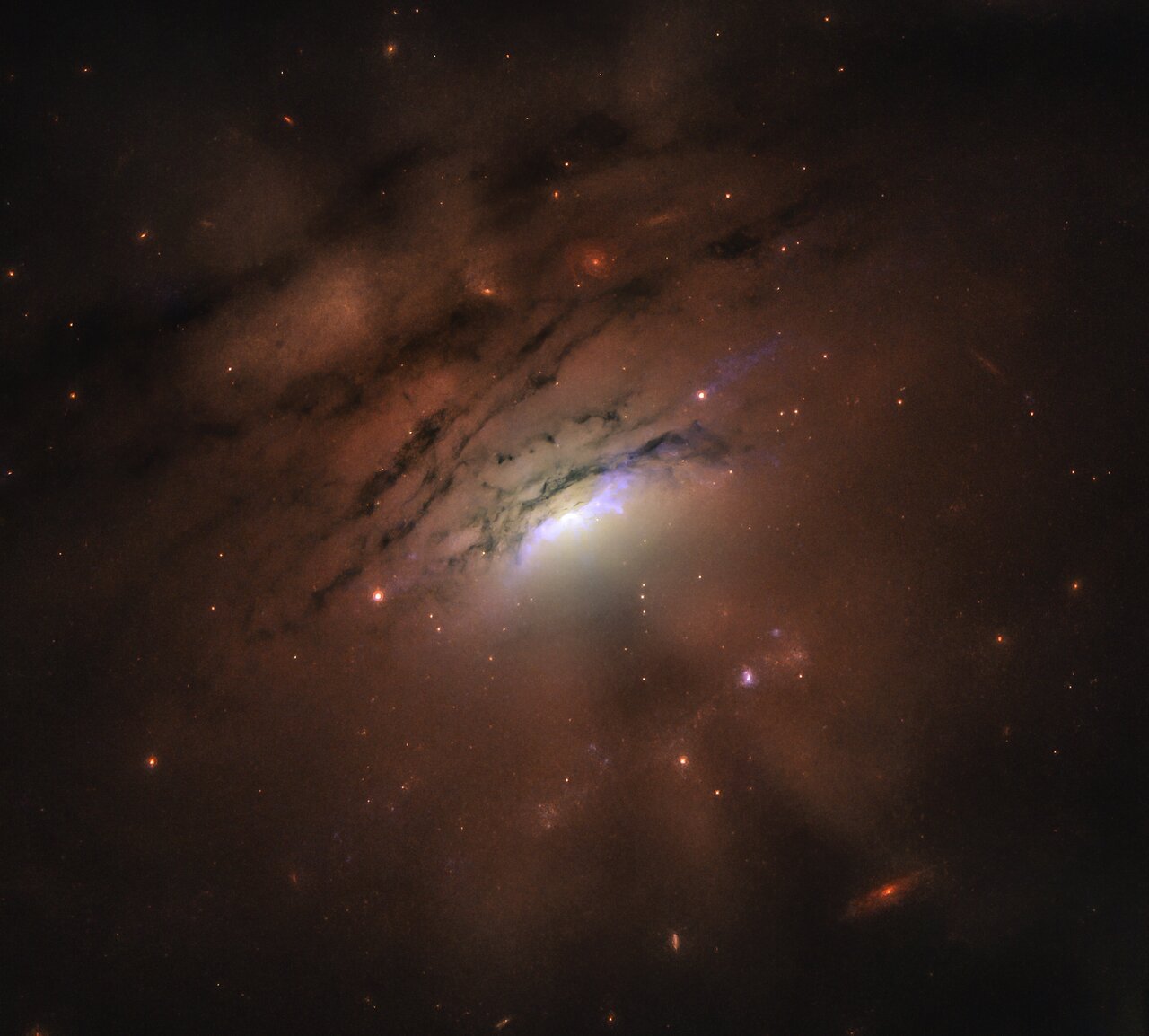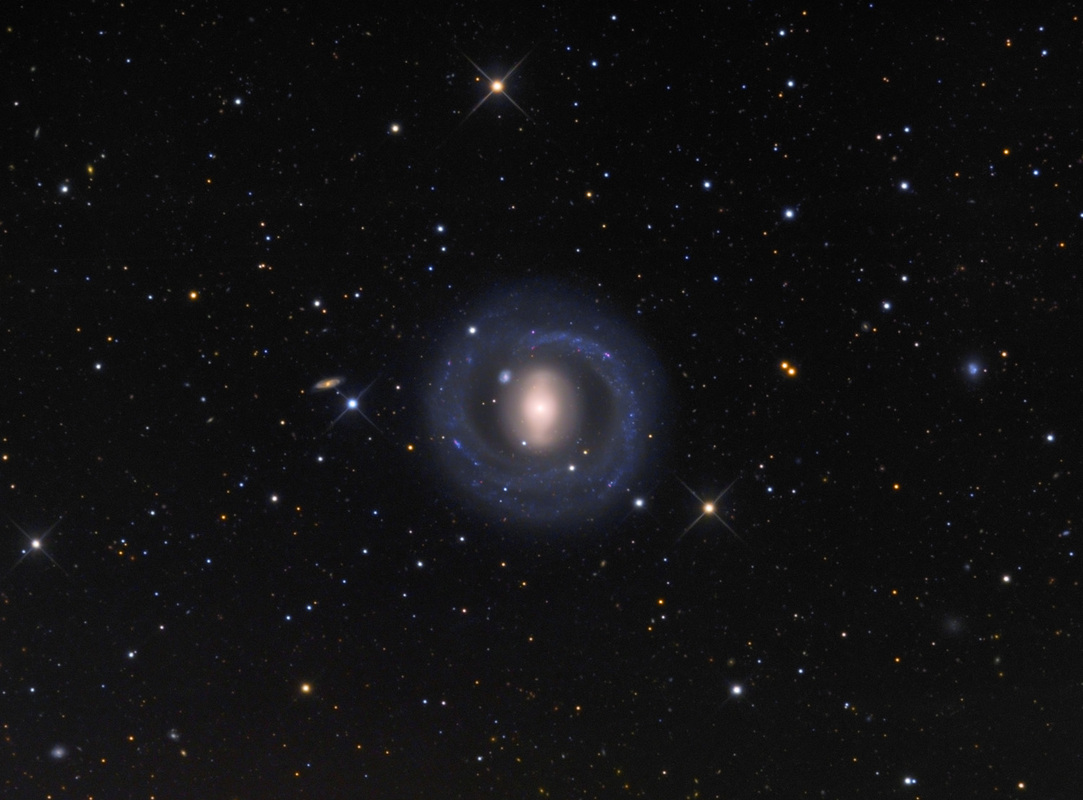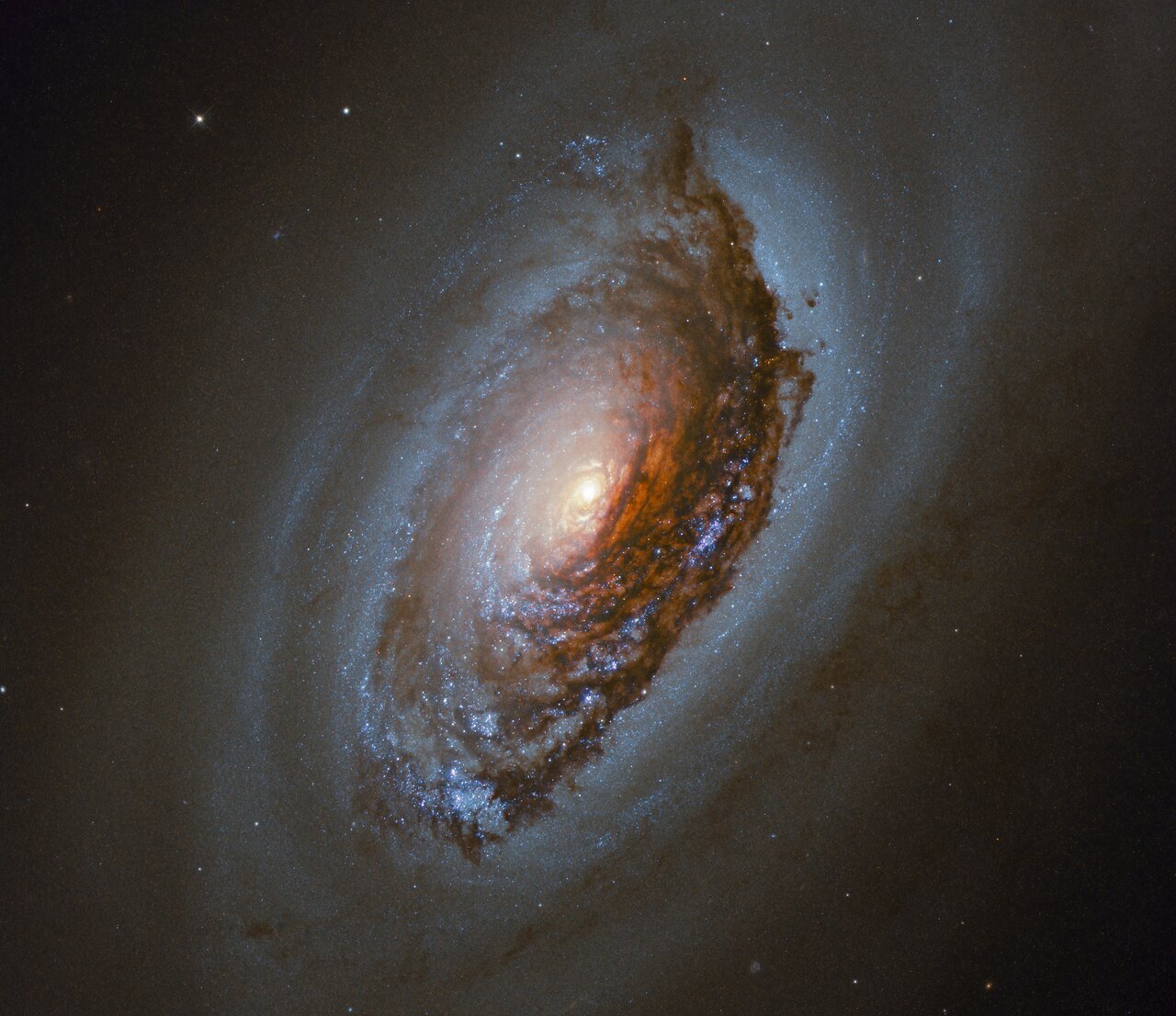Blog
Some of the most stunning views of our sky occur at sunset, when sunlight pierces the clouds, creating a mixture of bright and dark rays formed by the clouds’ shadows and the beams of light scattered by the atmosphere. Astronomers studying the nearby galaxy IC 5063 are tantalized by a similar effect in this new image from the NASA/ESA Hubble Space Telescope. In this case, a collection of narrow bright rays and dark shadows is seen beaming out of the blazingly bright center of the active galaxy, shooting across at least 36,000 light-years. Astronomers have traced the rays back to the galaxy’s core, the location of an active supermassive black hole. The black hole is feeding on infalling material, producing a powerful gusher of light from superheated gas near it. Although the researchers have developed several plausible theories for the lightshow, the most intriguing idea suggests that the shadows are being cast into space by an inner tube-shaped ring, or torus, of dusty material surrounding the black hole. IC 5063 resides 156 million light-years from Earth.

Lewis Brian Hopkin Jones (28 February 1942 – 3 July 1969) was an English musician and composer, best known as the founder and original leader of the Rolling Stones. Initially a slide guitarist, Jones went on to play a wide variety of instruments on Rolling Stones recordings and in concerts, including rhythm guitar, lead guitar, sitar, dulcimer, various keyboard instruments such as piano and mellotron, marimba, wind instruments such as harmonica, recorder, saxophone, as well as drums, vocals and numerous others.
After he founded the Rolling Stones as a British blues outfit in 1962, and gave the band its name, Jones’ fellow band members Keith Richards and Mick Jagger began to take over the band’s musical direction, especially after they became a successful songwriting team. Jones and fellow guitarist Richards also developed a unique style of guitar play that Richards refers to as the “ancient art of weaving” where both players would play rhythm and lead parts together. Richards continued the style with later guitarists, and the sound became a Rolling Stones trademark. Jones, however, did not get along with the band’s manager, Andrew Loog Oldham, who pushed the band into a musical direction at odds with Jones’ blues background.
When Jones developed alcohol and drug problems, his performance in the studio became increasingly unreliable, leading to a diminished role within the band he had founded. In June 1969, the Rolling Stones dismissed Jones; guitarist Mick Taylor took his place in the group. Jones died less than a month later, drowning in the swimming pool at his home at the age of 27. Jones’s death was referenced in songs by many other pop-bands, and was the subject of poems by Pete Townshend and Jim Morrison. Referring to Jones, the Rolling Stones’ Bill Wyman lamented the waste of a great innovator. In 1989, the Rolling Stones, including Jones, were inducted into the Rock and Roll Hall of Fame.
more...John Aloysius Fahey (/ˈfeɪhi/ FAY-hee; February 28, 1939 – February 22, 2001) was an American fingerstyle guitarist and composer who played the steel-string acoustic guitar as a solo instrument. His style has been enormously influential and has been described as the foundation of the genre of American primitive guitar, a term borrowed from painting and referring mainly to the self-taught nature of the music and its minimalist style. Fahey borrowed from the folk and blues traditions in American roots music, having compiled many forgotten early recordings in these genres. He would later incorporate 20th-century classical, Portuguese, Brazilian, and Indian influences into his work.
Fahey spent many of his later years in poverty and poor health, but enjoyed a minor career resurgence in the late 1990s, with a turn towards the avant-garde. He also created a series of abstract paintings in his final years. Fahey died in 2001 from complications from heart surgery. In 2003, he was ranked 35th on Rolling Stone magazine’s “100 Greatest Guitarists of All Time” list.
Fahey was born into a musical household in Washington, D.C. in 1939. Both his father, Aloysius John Fahey, and his mother, Jane (née Cooper), played the piano. In 1945, the family moved to the Washington suburb of Takoma Park, Maryland, where his father lived until his death in 1994. On weekends, the family attended performances of the top country and bluegrass acts of the day, but it was hearing Bill Monroe‘s version of Jimmie Rodgers‘ “Blue Yodel No. 7” on the radio that ignited the young Fahey’s passion for music.
more...William Correa (February 28, 1934 – September 15, 1983), better known by his stage name Willie Bobo, was an American Latin jazz percussionistof Puerto Rican descent. Correa grew up in Spanish Harlem, New York City.
Correa became a noted timbales performer in Latin jazz, specifically Afro-Cuban jazz, in the 1960s and 1970s. He met Mongo Santamaría shortly after his arrival in New York and studied with him while acting as his translator, and later at the age of 19 joined Tito Puente for four years.
The nickname Bobo is said to have been originated by the jazz pianist Mary Lou Williams in the early 1950s.
Correa joined George Shearing‘s band on the album The Shearing Spell. After leaving Shearing, Cal Tjader asked Bobo and Santamaría to become part of the Cal Tjader Modern Mambo Quintet, who released several albums as the mambo craze reached fever pitch in the late 1950s. Reuniting with his mentor Santamaría in 1960, the pair released the album Sabroso! for the Fantasy label. Bobo later formed his own group, releasing Do That Thing/Guajira with Tico and Bobo’s Beat and Let’s Go Bobo for Roulette, without achieving huge penetration.
After the success of Tjader’s Soul Sauce, in which he was heavily involved, Correa formed a new band with the backing of Verve Records, releasing Spanish Grease, the title track being perhaps his most well known tune. Highly successful at this attempt, Correa released a further six albums with Verve.
more...Svend Asmussen (28 February 1916 – 7 February 2017) was a Danish jazz violinist, known as “The Fiddling Viking”.[1] A Swing style virtuoso, he played and recorded with many of the greats of Jazz, including Duke Ellington, Benny Goodman and Stephane Grappelli. He played publicly until 2010 when he had a blood clot, his career having spanned eight decades. Asmussen was born in Copenhagen, Denmark, raised in a musical family, and started taking violin lessons at the age of 7. At age 16 he first heard recordings by jazz violin great Joe Venuti and began to emulate his style. He started working professionally as a violinist, vibraphonist, and singer at age 17, leaving his formal training behind for good. Early in his career he worked in Denmark and on cruise ships with artists such as Josephine Baker and Fats Waller. Asmussen later was greatly influenced by Stuff Smith, whom he met in Denmark. Asmussen played with Valdemar Eiberg and Kjeld Bonfils during World War II, during which time jazz had moved to the underground and served as a form of political protest.
more...https://www.youtube.com/watch?v=U0qVp5dbz2E
more...NGC 5701 is a lenticular SB0-a-type galaxy in the constellation Virgo , approximately 68 million light years from the Milky Way. The galaxy was discovered on April 29, 1786 by the German-British astronomer William Herschel .
Dexter Gordon (February 27, 1923 – April 25, 1990) was an American jazz tenor saxophonist. He was among the most influential early bebopmusicians, which included other greats such as Charlie Parker, Dizzy Gillespie, and Bud Powell. Gordon’s height was 6 feet 6 inches (198 cm), so he was also known as “Long Tall Dexter” and “Sophisticated Giant”. His studio and performance career spanned over 40 years.
Gordon’s sound was commonly characterized as being “large” and spacious and he had a tendency to play behind the beat. He was known for inserting musical quotes into his solos, with sources as diverse as “Happy Birthday” and well known melodies from the operas of Wagner. This is not unusual in jazz improvisation, but Gordon did it frequently enough to make it a hallmark of his style. One of his major influences was Lester Young. Gordon, in turn, was an early influence on John Coltrane and Sonny Rollins. Rollins and Coltrane then influenced Gordon’s playing as he explored hard bop and modal playing during the 1960s. Gordon was known for his genial and humorous stage presence. He was an advocate of playing to communicate with the audience, which was his musical approach as well. His improvisation was remarkably engaging and intelligent, but never gratuitously complex or unusual. It was always a conversation simultaneously delightful and intellectual. One of his idiosyncratic rituals was to recite lyrics from each ballad before playing it. A photograph by Herman Leonard of Gordon taking a smoke break at the Royal Roost in 1948 is one of the iconic images in jazz photography.Cigarettes were a recurring theme on covers of Gordon’s albums.
Gordon was nominated for an Academy Award for Best Actor in a Leading Role for his performance in the Bertrand Tavernier film Round Midnight(Warner Bros, 1986), and he won a Grammy for Best Jazz Instrumental Performance, Soloist, for the soundtrack album The Other Side of Round Midnight (Blue Note Records, 1986). He also had a cameo role in the 1990 film Awakenings. In 2018, Gordon’s album Go (Blue Note, 1962) was selected by the Library of Congress for preservation in the National Recording Registry for being “culturally, historically, or aesthetically significant”.
more...Chuck Wayne (February 27, 1923 – July 29, 1997) was a jazz guitarist. He came to prominence in the 1940s, and was among the earliest jazz guitarists to play in the bebop style. Wayne was a member of Woody Herman‘s First Herd, the first guitarist in the George Shearing quintet, and Tony Bennett‘s music director and accompanist. He developed a systematic method for playing jazz guitar.
Wayne was known for a bebop style influenced by saxophone players of his time, especially Charlie Parker and Coleman Hawkins. In an era when many guitarists used four-square, mandolin-style picking, with rigid up-down stroke articulation, Wayne developed a technique not widely adopted by others until decades later. He also developed a comprehensive approach to guitar chords and arpeggios – based on generic tetrad forms spanning all possible inversions, in varying degrees of open voicing. This highly analytic approach to the fretboard was later documented in a series of theory books, some released posthumously. Chuck Wayne was born Charles Jagelka in New York City to a Czechoslovakian family. As a boy he learned banjo, mandolin, and balalaika. In the early 1940s he began playing in jazz bands on 52nd Street. After two years in the Army, he returned to New York City, joined Joe Marsala‘s band, and settled in Staten Island (until a 1991 move to New Jersey). He changed his musical style after hearing Charlie Parker, recording with Dizzy Gillespie in 1945.
more...Freddie Keppard (sometimes rendered as Freddy Keppard) (February 27, 1889 – July 15, 1933) was an early jazz cornetist who once held the title of “King” in the New Orleans jazz scene. This title was previously held by Buddy Bolden and succeeded by Joe Oliver.
Keppard (pronounced in the French fashion, with relatively even accentuation and a silent d) was born in the Creole of Color community of downtown New Orleans, Louisiana.
more...This NASA/ESA Hubble Space Telescope Picture of the Week features NGC4826 — a spiral galaxy located 17 million light-years away in the constellation of Coma Berenices (Berenice’s Hair). This galaxy is often referred to as the “Black Eye”, or “Evil Eye”, galaxy because of the dark band of dust that sweeps across one side of its bright nucleus.
NGC4826 is known by astronomers for its strange internal motion. The gas in the outer regions of this galaxy and the gas in its inner regions are rotating in opposite directions, which might be related to a recent merger. New stars are forming in the region where the counter rotating gases collide. This galaxy was first discovered in 1779 by the English astronomer Edward Pigott.

Mitch Ryder (born William Sherille Levise, Jr.; February 26, 1945) is an American musician who has recorded more than 25 albums over more than four decades.
Ryder is noted for his gruff, wailing singing style and his dynamic stage performances. He was influenced by his father, a musician. As a teenager, Ryder sang backup with a black soul-music group known as the Peps, but racial animosities interfered with his continued presence in the group.
Ryder formed his first band, Tempest, when he was at Warren High School, and the group gained some notice playing at a Detroit soul music club called The Village. Ryder next appeared fronting a band named Billy Lee & The Rivieras, which had limited success until they met songwriter / record producer Bob Crewe. Crewe renamed the group Mitch Ryder & The Detroit Wheels, and they recorded several hit records for his DynoVoice Records and New Voice labels in the mid to late 1960s, most notably “Devil with a Blue Dress On“, their highest-charting single at number four, as well as “Jenny Take a Ride!”, which reached number 10 in 1965, and “Sock It to Me, Baby!”, a number six hit in 1967. The Detroit Wheels were John Badanjek on drums, Mark Manko on lead guitar, Joe Kubert (not to be confused with the comic book illustrator Joe Kubert) on rhythm guitar, Jim McCarty (not to be confused with the Yardbirds drummer of the same name) on lead guitar and Jim McAllister on bass.
more...
More Posts
- The Cosmos with NGC 6820/3
- Pat Martino Day
- Wayne Shorter Day
- World Music with Songhoy Blues
- Daily Roots with Johnny Osborne
- The Cosmos with NGC 4100
- Jim Capaldi Day
- Arthur “Big Boy” Crudup Day
- World Music with Cayetano Moreno Castro
- Daily Roots with Cornell Campbell
- The Cosmos with NGC 6503
- Keith Moon Day
- Terje Rypdal Day
- Gil Coggins Day
- World Music with AL-Mawror
- Daily Roots with Carlton and the Shoes
- The Cosmos with N159W
- Malachi Favors Day
- John Lee Hooker Day
- World Fusion with Azam Ali